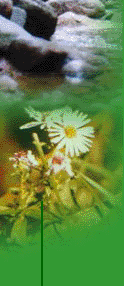|
ACCUPRESSURE:
Ancient Oriental technique, applying
finger pressure to vital body points, or meridians, to ease muscle tension and increase the bodys flow of energy.
ACCUPUNCTURE:
A relatively painless, ancient Oriental healing technique that relieves pain through puncturing specific areas of
the skin with needles. The needles replace finger pressure on the bodys meridians and trigger points, and stimulate the nerves
as they are turned.
AROMATHERAPY MASSAGE:
Aromatherapy is a term coined by French
chemist Maurice Gattefosse in the 1920s, and this particular form of therapy dates back to 4500 B.C. It is the art of using
fragrant, botanical essential oils to promote well-being, either applied to the skin (in the case of massage) or inhaled.
This has become increasingly popular and is incorporated into facials, body wraps, hydro baths and personal products. The
scent from each specific plant is supposed to have different healing effects on the body.
BIOENERGETICS:
The term applied to the exchange of energy between persons giving and receiving massage or body work, and in my opinion,
a critical component of the massage.
CRANIAL-SACRAL THERAPY:
This gentle massage focuses
on the head and releases energy blockage, also an essential component to therapeutic massage. It is extremely relaxing, and
it is at this point during my massages that most of my focus on bioenergetics occurs.
ESALEN MASSAGE:
This particular type of massage was developed by the Esalen Institute in California, and combines basic Swedish massage
techniques with sensory relaxation techniques. It is a particularly soothing type of massage due to continual touch and long
hand strokes, and is described as both energetic and relaxing as it releases muscle tension while harmonizing the body. It
is also an essential element of the type of massage I usually give.
LYMPHATIC DRAINAGE MASSAGE:
This gentle pumping technique works the face and neck, or the entire body, to drain areas of water retention, release
toxins and stimulate lymphatic circulation via manual massage techniques. It is considered a premier, anti-aging treatment
and increased lymphatic circulation directly assists the bodys ability to eliminate wastes and absorb nutrients. Increased
stimulation to the lymphatic system is also designed to enhance the bodys natural immune capabilities.
MYOFASCIAL
THERAPY:
Neuromuscular therapy brings relief for chronic muscle tightness by focusing on particular areas
rather than all-around massage. This technique deeply kneads and separates muscle groups, loosening the fascia (the thick
layer of connective tissue covering and supporting the muscles) to promote realignment and freedom of movement; at times it
can be experienced as painful, but usually only because of existing tension and stress already focused in the area in question.
"Trigger point" therapy also can be used in this technique.
NEUROMUSCULAR MASSAGE:
Neuromuscular
therapy brings relief for chronic muscle tightness by focusing on particular areas rather than all-around massage. "Trigger
point" therapy also can be used in this technique. This therapy that affects both the muscles and the nerves.
PHYTOTHERAPY:
Healing through plants. Treatments include the use of botanical extracts, herbs and essential oils applied through
massage, body wraps, water and steam therapies; and can also be found in herbal teas.
REFLEXOLOGY:
This ancient Chinese technique uses thumb and finger pressure point massage applied to nerve endings, (typically on
hands, feet, and ears) that correspond to internal organs in order to restore the flow of energy and effect healing in the
specific targeted areas. There are very specific points on the hands, feet and ears that correspond to the nerve endings to
particular organs and muscles. Hence, manipulation of those areas is essentially a long distance type of therapy that travels
along the nerve pathways.
REIKI:
Developed by Ida Rolf, this is an intense series
of sessions which manipulate rigid muscles, bones and joints, structurally re-balancing the body for improved movement. It
is often related to emotional trauma and is a means to relieve the stress induced by the trauma. It is an intense treatment,
and can sometimes be perceived as painful. (See Deep Tissue Massage).
SHIATSU MASSAGE:
Developed
in Japan, this cross between accupressure and other massage techniques applies pressure to vital points and energy meridians
to stimulate energy flow and healing. It literally means finger (shi) pressure (atsu).
SPORTS MASSAGE:
A deep tissue massage which readies an athlete for peak performance by increasing circulation in the muscles, bringing
nutrients in and carrying away metabolic waste more efficiently. It is designed to relieve pain in specific muscles as they
relate to athletic activities. Used pre- or post-event, it either serves as a preliminary warm-up to an event, or to relieve
the pain after an event due to the buildup of lactic acid in the muscle tissue which occurs after strenuous exercise.
SWEDISH
MASSAGE:
Probably the most familiar type of massage, this European style uses a variety of strokes, including
gentle, long-kneading strokes of all the major muscle groups. This eases tension, improves flexibility, increases circulation
(which carries off waste products stored in the muscle and adipose tissue) and promotes relaxation.
THERAPEUTIC
TOUCH:
The laying on of the therapists hands on the body is meant to impart and channel energy and healing,
and release energy and emotional blockages. The more natural healer the therapist is, the more effective the actual touch
aside from whatever specific manipulation of the muscles is practiced.
TRAGER MASSAGE:
This
bodywork technique was developed by Dr. Milton Traeger, a Hawaiian physician, using gentle, rhythmic shaking movements to
release tension from the joints. Unlike other massage, there is no force, pressure or oils. A series of sessions is recommended
as the benefits appear cumulative.
WATSU:
Watsu (coming from WAter shiatSU) is, at
its simplest level, a floating massage in warm water here muscles are massaged, joints mobilized, tissues stretched, energy
pathways opened, as the whole body is gently swished and swayed through the water.
Portions
of the above information partially acquired from eBody.com
|




